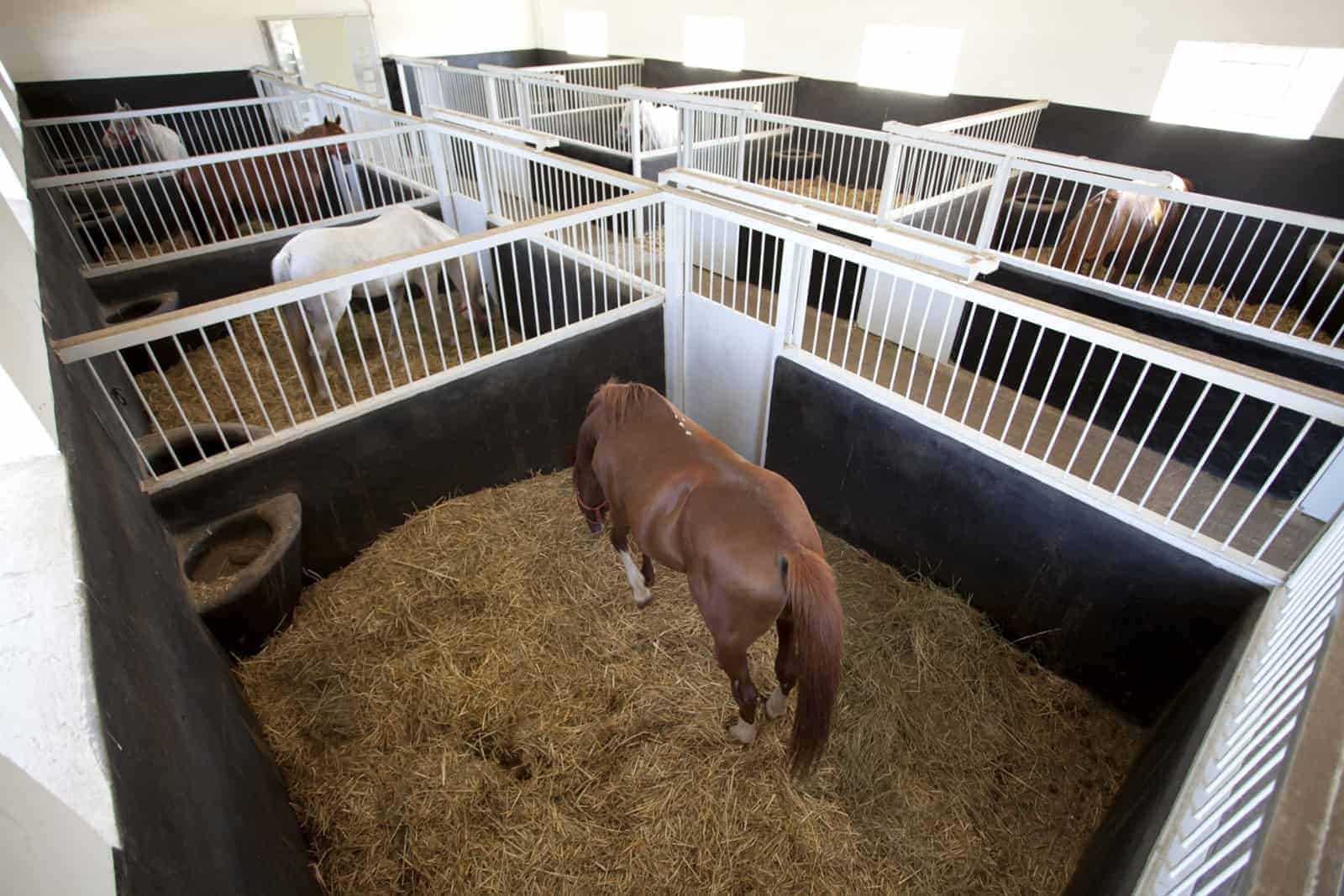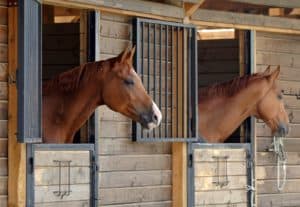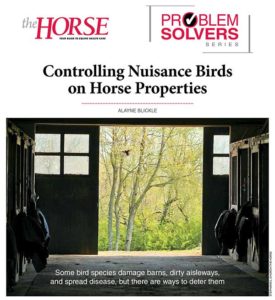Healthful Horse Barns

Consider these horse health and safety-oriented design aspects when building or renovating your barn
Hurrah, it’s time for a barn raising! Or maybe a barn re-raising, if your current barn needs a renovation. But as you’re thinking about plans for building or rebuilding, remember: Think horse, not human. While barns can be aesthetically pleasing and designed for human comfort, your stabling system’s primary purpose is to maintain its four-hoofed tenants’ security and well-being.
Why a Barn?
Despite traditions, even the finest competition horses don’t need a fancy stall-lined stable. Melissa Mazan, DVM, Dipl. ACVIM, associate professor at Tufts University’s Cummings School of Veterinary Medicine, in North Grafton, Massachusetts, says all most horses really need is a place to escape the wind and rain.
“Horses are usually very happy just having access to a three-sided shelter; even in pretty severe weather, it’s usually more than enough for a horse,” she says.
But it’s usually not enough for us humans. We need (and prefer) to be warmer and drier. That’s also true of horses that no longer have their natural winter coats after clipping, Mazan says. “Those horses really do need a barn because they no longer have their own natural protection against the elements,” she adds.
Barns also provide a secure way to prevent horses from fighting and bickering, especially if space is limited. Anton Fürst, PhD, DVM, Dipl. ECVS, head of the University of Zürich’s equine department, in Switzerland, says that unless you have the time, space, and experience to closely monitor and manage horses in a herd, they might be better off housed in individual stalls.
“A lot of times we get people saying they want a ‘natural environment’ for their horses, so they’ll put them together in a group, whether indoors or outdoors,” he explains. “And then we see a lot of injuries from biting and kicking mostly, sometimes very serious injuries. It’s one of the main mistakes we see horse owners making.”
If you’re among the majority of horse owners who do need a barn, then consider the following suggestions to make your new (or newly renovated) structure one that is safe and designed to promote your horses’ good health and well-being.
The Indoor/Outdoor Plan
Mazan and Fürst agree that the ideal barn would be comprised of individual stalls leading to individual paddocks that horses can enter and exit at will. This allows horses to breathe fresh air, move around as they need to, and enjoy the outdoors. Paddock time also reduces the risk of horses developing certain “diseases of domestication,” says Mazan, such as colic, laminitis, and metabolic syndrome (the latter two due to lack of exercise if stabled most of the time, as exercise helps the body regulate insulin). “You’re just not going to see these as much if your horses aren’t kept in a stall all day long,” she adds.
Horses constantly cooped up indoors are also more prone to stress-related ulcers and injury, Fürst adds. Eager to get out and see what’s going on around them, many horses can get hurt while moving around within a stall’s confined space.
Letting it Breathe

Perhaps the most important thing to remember when building your barn is making sure it can “breathe.” Without proper ventilation, the barn might feel warmer to you, but it’s hard on the lungs–both yours and your horse’s. Moisture builds up inside a closed-up barn, which can mean mold breeding even in the cleanest of spaces, says Mazan. Polluting gases such as ammonia and carbon dioxide also build up in the air and cause respiratory problems. “Certainly being closed up is just a bad, bad idea,” she says. “You (and your horses) need ventilation, just like you do in a house.”
Windows to the outside are a must, both for your horse’s happiness and lung health, as are eave openings. Barns should also have a cupola on top that allows air to move both into and out of the stable, she adds. A building with good ventilation, however, does not allow drafts of cold air.
Proper ventilation is a science in itself, with recommended air exchange rates based on number of horses housed, barn size, and insulation type. To ensure you have optimal ventilation, check with your state agricultural department. Or better yet, Mazan says, hire an expert to investigate and provide advice for your situation.
Controlling Temperature
Ideal barn temperature in winter should probably be similar to the current outdoor temperature, notes Mazan. However, extreme weather conditions can make the barn feel unpleasant to humans or might cause water and water pipes to freeze. Insulating a barn can help preserve heat while still allowing proper air flow. Owners can install artificial heat in barns located in exceptionally cold climates, but they should be aware of any fire hazard potential and should try to maintain the temperature no higher than 55°F (12°C).
Controlling Dust
“The biggest problem in barns is dust,” says Mazan. As horses inhale dust, they can develop respiratory inflammation that can lead to poor performance and in some cases chronic inflammatory airway disease. Limit dust in your barn by storing hay in a separate building (which will also reduce your fire risk).
As another dust-reducing method, soak hay rations for at least 30 minutes before serving them to horses. Keep in mind, however, that soaking hay requires significant water resources, and water should be disposed of after every use (and not reused or offered to horses). Alternately, avoid dust by feeding hay on the ground. Mazan says researchers have shown there is a much higher dust load to the respiratory system if you feed from a manger or a hay bag. You might also consider using pelleted bedding, which is a low-dust and heat-sterilized alternative to traditional straw, wood shavings, or sawdust.
And while the convenience of having an indoor arena attached to your stable might be attractive, spare your horses’ lungs by constructing it as a separate building. “Indoor arenas are a big source of increased dust and particulates,” Mazan says.
Quarantine and Infirmary
If it’s not possible to construct a separate structure, design a quarantine section for housing sick or newly arrived horses as far from the other horses in your barn as possible to prevent potential disease spread, says Mazan. Plan for two or three easy-to-clean stalls that can be closed up securely so quarantined horses are less likely to share airspace with healthy ones.
If possible, designate a separate infirmary area for lame and injured horses. Ideally these stalls have better lighting and access to veterinary supplies. Keeping invalid horses together in one area also reduces their stress levels while the healthy horses are ridden or turned out. Even if you only have one “patient” in your infirmary at a time, plan to keep a visitor in the stall next door, says Fürst. Horses left alone are prone to injury, or reinjury, because they can become nervous or overly excited.
Fixtures and Separations
Reduce injury risk by planning appropriately sized openings in the walls. Keep windows high and large enough that a horse isn’t likely to get his head or leg stuck in them, which is a common barn accident, says Fürst. Build solid walls (no holes or board spacing) between stalls to prevent biting and kicking injuries (from horses interacting with one another) or hooves getting caught. Also, construct stalls large enough for rolling and turning (at least 10-by-10 feet, but ideally 12-by-12), and plan for plenty of ceiling height so the horse doesn’t hit his head if he rears.
Sturdy fencelines are sufficient for individual outdoor paddocks, Fürst says, as long as barrier-sharing horses have enough room to get away from each other if they’re showing aggression. (However, mares with foals should not share fencelines with other horses in situations like this, he adds, as they can be much more aggressive.)
Add safe tack hooks on or near each stall door for hanging the halter, as Fürst warns that horses should never be stalled wearing their halters. He says they always seem to find something to catch the halter on–particularly their own feet.
Flooring
Barn flooring choice is another important safety consideration, Fürst adds. Concrete covered with drainable rubber matting is ideal because it provides a nonslip surface (which is especially important for horses with shoes), its cushion is gentle on equine joints, and it is easy to clean. However, mats can trap underlying moisture, so solid mats better protect your horses from oral-fecal diseases such as Salmonella infection, Mazan adds.
Bare earth isn’t as slippery as concrete without mats, but it’s much harder to keep clean and can still be very hard on joints, Fürst says. In either case, plan for good drainage in both stalls and aisles, and don’t use flat concrete flooring (some can be scored or textured for traction) without a mat in any part of the barn where a horse walks–including the stall.
Keep a comfortable layer of bedding in the stalls to cushion the horse’s body when he’s lying down or rolling, and plan for stall walls that run flush with the ground to prevent bedding wastage. See TheHorse.com/183072 for more information about mats, bedding, and flooring choices appropriate for all budgets and needs.
Critters

Wild animals, which might be attracted to the horse feed, shelter, and warmth your barn offers, can cause serious structural damage. Build a completely sealed-off room for your feed storage, and store feed in plastic tubs or, preferably, galzanized cans, as rodents can easily eat through paper sacks and some plastic. Make sure the barn’s outer walls are flush with the ground with no holes or gaps where rodents could enter. Set traps or find a good barn cat for mousing; avoid using poison, especially if you have dogs. To deter larger animals such as foxes, neighborhood dogs, raccoons (which might have rabies), and opossums (which can host the causative agent of equine protozoal myeloencephalitis) from running under your fences or getting into your barn, Fürst recommends creating low barriers around your paddocks.
Take-Home Message
Building or renovating your barn can be an exciting project, but it’s important to step away from a dream barn based on tradition and take advantage of what veterinarians know about stabling’s impact on horse health. Modern barn designs can promote safety and good health while still being beautiful structures worthy of your prized mounts.

Written by:
Christa Lesté-Lasserre, MA
Related Articles
Stay on top of the most recent Horse Health news with















